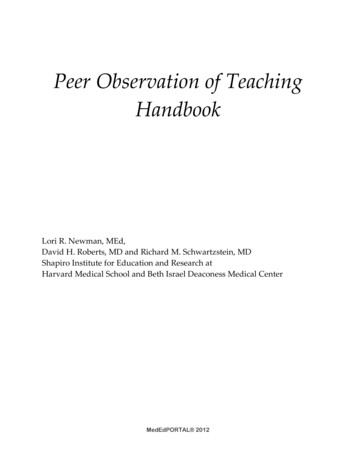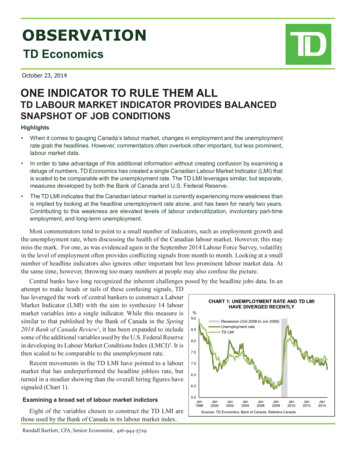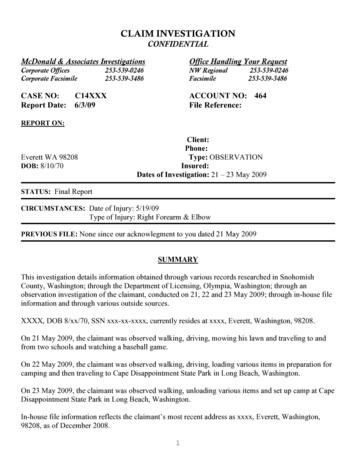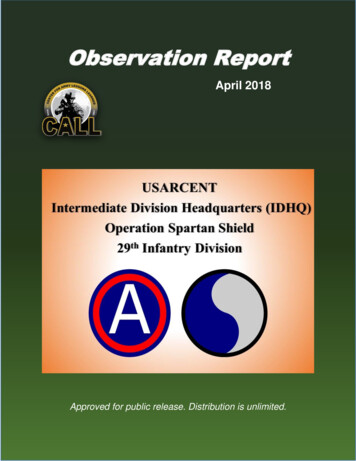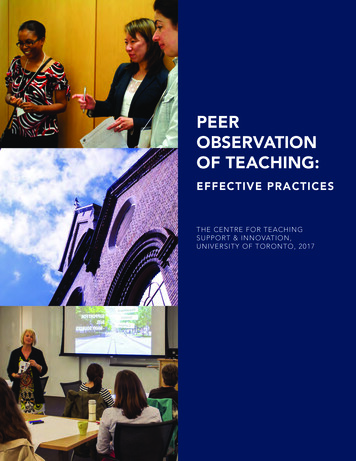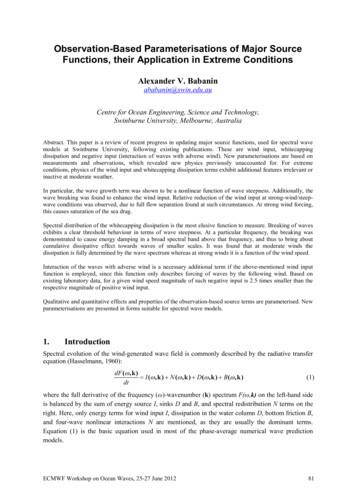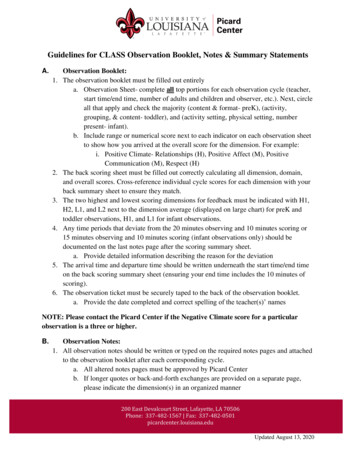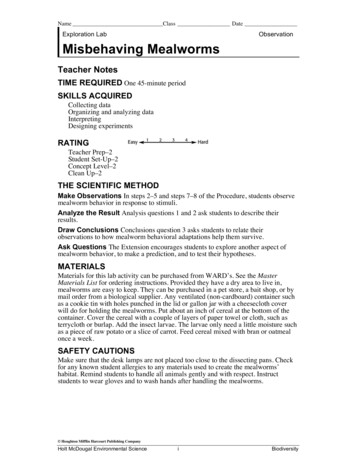
Transcription
Name Class DateExploration LabObservationMisbehaving MealwormsTeacher NotesTIME REQUIRED One 45-minute periodSKILLS ACQUIREDCollecting dataOrganizing and analyzing dataInterpretingDesigning experimentsRATINGTeacher Prep–2Student Set-Up–2Concept Level–2Clean Up–2THE SCIENTIFIC METHODMake Observations In steps 2–5 and steps 7–8 of the Procedure, students observemealworm behavior in response to stimuli.Analyze the Result Analysis questions 1 and 2 ask students to describe theirresults.Draw Conclusions Conclusions question 3 asks students to relate theirobservations to how mealworm behavioral adaptations help them survive.Ask Questions The Extension encourages students to explore another aspect ofmealworm behavior, to make a prediction, and to test their hypotheses.MATERIALSMaterials for this lab activity can be purchased from WARD’s. See the MasterMaterials List for ordering instructions. Provided they have a dry area to live in,mealworms are easy to keep. They can be purchased in a pet store, a bait shop, or bymail order from a biological supplier. Any ventilated (non-cardboard) container suchas a cookie tin with holes punched in the lid or gallon jar with a cheesecloth coverwill do for holding the mealworms. Put about an inch of cereal at the bottom of thecontainer. Cover the cereal with a couple of layers of paper towel or cloth, such asterrycloth or burlap. Add the insect larvae. The larvae only need a little moisture suchas a piece of raw potato or a slice of carrot. Feed cereal mixed with bran or oatmealonce a week.SAFETY CAUTIONSMake sure that the desk lamps are not placed too close to the dissecting pans. Checkfor any known student allergies to any materials used to create the mealworms’habitat. Remind students to handle all animals gently and with respect. Instructstudents to wear gloves and to wash hands after handling the mealworms. Houghton Mifflin Harcourt Publishing CompanyHolt McDougal Environmental ScienceiBiodiversity
Name Class DateTEACHER RESOURCE PAGEMisbehaving Mealworms continuedDISPOSALChange the vegetables every couple of days. Wet food left in the container can getmoldy after several days. Remove and discard if this happens. Mold and dampnesswill kill the mealworms. Once your experiments are finished, you can dispose of themealworms by releasing them outside into the soil.MISCONCEPTION ALERTDespite their outward appearance, mealworms are not actually worms nor are theyrelated to earthworms. Point out that mealworms are actually the larval stage of asmall insect called the darkling beetle or Tenebrio molitor, which has been known toinfest grain and feed stores.If students are squeamish about handling the mealworms assure them that they arenot slimy and that they do not bite.TIPS AND TRICKSGroups of 2–4 students work best for this activity.Tell students that animal behavior often is a response to stimuli in the animal’senvironment. Insect behavior is almost completely instinctual, which means thatinsects react in set, often predictable, ways to a given stimulus. A behavioral arenaallows an investigator to provide stimuli in a controlled environment and thereforedetermine the insect’s typical behavioral responses.Tell students that many of the mealworms’ behaviors are adaptations. Likephysical adaptations, behavioral adaptations help organisms survive and reproduce intheir natural environment. Houghton Mifflin Harcourt Publishing CompanyHolt McDougal Environmental ScienceiiBiodiversity
Name Class DateTEACHER RESOURCE PAGEMisbehaving MealwormsBehavior is the way an animal acts. Observing the responses of an animal to variouscues or stimuli tells us a great deal about the animal’s behavior. For example, if alizard perches on twigs in its terrarium, it is reasonable to guess that it is an arboreallizard and that it therefore naturally spends much of its life perched in the branches ofbushes or trees.In this lab, you will study the behavior of mealworms. Despite their name andappearance, mealworms are not worms; they are the larval stage of grain beetles.Adult grain beetles are black and shiny, but as larvae they look like small armoredworms. You will manipulate the environment of mealworms in various ways andobserve the reactions of the mealworms. You will then use your observations to betterunderstand the natural behavior of these larvae.OBJECTIVESObserve the behavior of mealworms.Deduce what types of lighting conditions and foods mealworms prefer by conductingexperiments.Explain how mealworms’ behavior helps them survive.MATERIALS aluminum foilbeaker, 150 mLbran flakescornflakesdesk lamp with an adjustable beam (optional)dissecting panindex cardmealwormsscissorssmall paintbrushsweet cerealtransparent tapewhite paperProcedurePART I—SET THE STAGE Houghton Mifflin Harcourt Publishing CompanyHolt McDougal Environmental ScienceiiiBiodiversity
Name Class DateTEACHER RESOURCE PAGEMisbehaving Mealworms continued1. First create a circular arena in which to observe the mealworms’ behavior. Usescissors to cut a sheet of plain white paper to fit the bottom of a dissecting pan.Tape the sheet into the pan, making sure that all edges are taped down, so themealworms can’t crawl under the paper. Trace a circle around the bottom of a 150mL beaker in the center of the paper. Why is it important to draw a behavioralarena?Answers may vary. Sample answer: The behavioral arena will helpstandardize our experiment because it ensures that each mealwormencounters the same experimental conditions.2. Fold an index card in half lengthwise and then open it up so that it can be used asa scoop. With a small paintbrush carefully brush 10 mealworms onto the card andtransfer them to a 150 mL beaker. Pour them all at once into the circle at thebottom of your pan. Arrange the mealworms around the outer edge of the circle,and space them apart as evenly as possible. Observe the mealworms for 2 to 3minutes. Describe what the mealworms look like and how they move.Answers may vary. Sample answers: tan/brown segmented body (looksstriped), center part of body is the fattest, six legs up front, tail has a spike, 2antennae; jumpy, crawling, very active.PART II—SOME LIKE IT DARK3. Fit a piece of aluminum foil tightly across the top of one half of the dissectingpan. Arrange the pan so that the uncovered side is well lighted but the coveredside is as dark as possible. You can do this more easily if you have a desk lampwith an adjustable beam. Observe the mealworms for between 5 to 10 minutes.4. How many mealworms moved into the lighted area? Into the shaded area? Whatlight conditions do the mealworms appear to prefer?Answers may vary. Most of the mealworms will probably have moved to thedark side of the pan.5. Are the mealworms bunched up or spread out? Where in the pan did they end up?Answers may vary. Sample answer: Mealworms generally prefer to huddletogether in dark corners.PART III—FLAKE CONNOISSEURS6. Transfer the mealworms back to the beaker, and remove the aluminum foil. Makefour piles of material (one pile each of white paper pieces, bran flakes, cornflakes,and sweet cereal) at equally spaced points around the circle. Which pile do youthink the mealworms will prefer? Why? Record your ideas.Answers may vary. Sample answer: The mealworms will move toward thepile of the best food source. This an adaptation that helps the larvae survive.7. Brush one mealworm at a time into the circle. Observe each mealworm for oneminute before adding another. Record how many mealworms visit each pile in thedata table on the next page. Also note if a mealworm does not visit any pile for afull minute. Houghton Mifflin Harcourt Publishing CompanyHolt McDougal Environmental ScienceivBiodiversity
Name Class DateTEACHER RESOURCE PAGEMisbehaving Mealworms continued8. Once all the mealworms are in the tray, observe their activity for 10 minutes andcontinue to record their visits to the piles.FOOD PREFERENCES OF MEALWORMSLocationInitial TallyFinal TallyBran FlakesCornflakesSweet CerealPaperNo PileAnalysis1. Describing Events Which pile was most preferred by the mealworms?Answers may vary. Sample answer: Mealworms normally prefer cereal topaper, and cornflakes are a big favorite.2. Describing Events How did the mealworms respond to the lighting?Answers may vary. Sample answer: They seem to prefer darkness.Conclusions3. Interpreting Information How do you think mealworms’ behavior helps themsurvive?Answers may vary. Sample answer: Mealworms’ preference for dark placesleads them to food sources they can burrow into, such as piles of stored grain,where they can also hide from predators.Extension1. Designing Experiments Now that you have observed mealworms’ reactions tolighting and types of food, write a hypothesis about another aspect of theirbehavior that you would like to explore. For example, what colors do they prefer,or on what type of surface do they move best? Make a prediction and conduct anexperiment to test your prediction. Explain your results to the class.Answers may vary. The experimental plan should be simple, practical, andscientifically sound. Houghton Mifflin Harcourt Publishing CompanyHolt McDougal Environmental SciencevBiodiversity
Name Class DateExploration LabObservationMisbehaving MealwormsBehavior is the way an animal acts. Observing the responses of an animal to variouscues or stimuli tells us a great deal about the animal’s behavior. For example, if alizard perches on twigs in its terrarium, it is reasonable to guess that it is an arboreallizard and that it therefore naturally spends much of its life perched in the branches ofbushes or trees.In this lab, you will study the behavior of mealworms. Despite their name andappearance, mealworms are not worms; they are the larval stage of grain beetles.Adult grain beetles are black and shiny, but as larvae they look like small armoredworms. You will manipulate the environment of mealworms in various ways andobserve the reactions of the mealworms. You will then use your observations to betterunderstand the natural behavior of these larvae.OBJECTIVESObserve the behavior of mealworms.Deduce what types of lighting conditions and foods mealworms prefer by conductingexperiments.Explain how mealworms’ behavior helps them survive.MATERIALS aluminum foilbeaker, 150 mLbran flakescornflakesdesk lamp with an adjustable beam (optional)dissecting panindex cardmealwormsscissorssmall paintbrushsweet cerealtransparent tapewhite paper Houghton Mifflin Harcourt Publishing CompanyHolt McDougal Environmental Science1Biodiversity
Name Class DateMisbehaving Mealworms continuedProcedurePART I—SET THE STAGE1. First create a circular arena in which to observe the mealworms’ behavior. Usescissors to cut a sheet of plain white paper to fit the bottom of a dissecting pan.Tape the sheet into the pan, making sure that all edges are taped down, so themealworms can’t crawl under the paper. Trace a circle around the bottom of a 150mL beaker in the center of the paper. Why is it important to draw a behavioralarena?2. Fold an index card in half lengthwise and then open it up so that it can be used asa scoop. With a small paintbrush carefully brush 10 mealworms onto the card andtransfer them to a 150 mL beaker. Pour them all at once into the circle at thebottom of your pan. Arrange the mealworms around the outer edge of the circle,and space them apart as evenly as possible. Observe the mealworms for 2 to 3minutes. Describe what the mealworms look like and how they move.PART II—SOME LIKE IT DARK3. Fit a piece of aluminum foil tightly across the top of one half of the dissectingpan. Arrange the pan so that the uncovered side is well lighted but the coveredside is as dark as possible. You can do this more easily if you have a desk lampwith an adjustable beam. Observe the mealworms for between 5 to 10 minutes.4. How many mealworms moved into the lighted area? Into the shaded area? Whatlight conditions do the mealworms appear to prefer?5. Are the mealworms bunched up or spread out? Where in the pan did they end up?PART III—FLAKE CONNOISSEURS6. Transfer the mealworms back to the beaker, and remove the aluminum foil. Makefour piles of material (one pile each of white paper pieces, bran flakes, cornflakes,and sweet cereal) at equally spaced points around the circle. Which pile do youthink the mealworms will prefer? Why? Record your ideas.7. Brush one mealworm at a time into the circle. Observe each mealworm for oneminute before adding another. Record how many mealworms visit each pile in thedata table on the next page. Also note if a mealworm does not visit any pile for afull minute. Houghton Mifflin Harcourt Publishing CompanyHolt McDougal Environmental Science2Biodiversity
Name Class DateMisbehaving Mealworms continued8. Once all the mealworms are in the tray, observe their activity for 10 minutes andcontinue to record their visits to the piles.FOOD PREFERENCES OF MEALWORMSLocationInitial TallyFinal TallyBran FlakesCornflakesSweet CerealPaperNo PileAnalysis1. Describing Events Which pile was most preferred by the mealworms?2. Describing Events How did the mealworms respond to the lighting?Conclusions3. Interpreting Information How do you think mealworms’ behavior helps themsurvive?Extension1. Designing Experiments Now that you have observed mealworms’ reactions tolighting and types of food, write a hypothesis about another aspect of theirbehavior that you would like to explore. For example, what colors do they prefer,or on what type of surface do they move best? Make a prediction and conduct anexperiment
In this lab, you will study the behavior of mealworms. Despite their name and appearance, mealworms are not worms; they are the larval stage of grain beetles. Adult grain beetles are black and shiny, but as larvae they look like small armored worms. You will manipulate the environment of mealworms in various ways and




